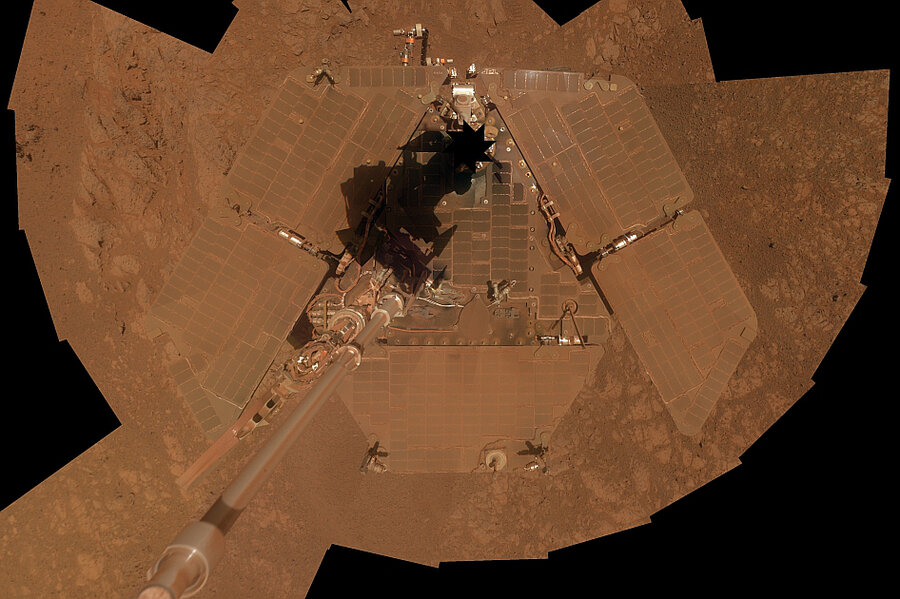The little rover that could? Opportunity turns 10, keeps on roving.
Loading...
On January 24, 2004, Opportunity touched down on the surface of Mars after a seven-month flight from Earth. Originally intended to last 90 Martian days, Opportunity's mission has been extended over and over again.
"No one ever expected this," says John Callas, project manager, "that after 10 years, the Mars Exploration Rover would continue to operate – and operate productively – on the surface of Mars."
"The real payoff from this mission started on the day Opportunity landed," said Michael Meyer, lead scientist of the MER team, at a press conference. "It began science operations that lasted over 10 years – 9.75 years beyond the rover's warranty. "
Opportunity has blown past every conceivable design expectation, says Dr. Callas. It was built to travel about half a mile from its landing site. "After 10 years, Opportunity has driven 38.7 km (24 miles) – fantastically more than the 1 kilometer requirement," he says. "We've survived more than 3,500 Martian days on the surface, and collected more than 170,000 images. But it's not how long the rover has lasted or how far it has driven, but the amount of scientific exploration that's been accomplished in that time. After 10 years, Opportunity is still in very good health and very scientifically productive."
What's the secret to the rover's longevity? Extraordinary engineering, an operations team that finds innovative ways to keep alive through the cold and dark Martian winter, and fortuitous wind storms, says Callas.
The rover is solar-powered, and NASA engineers learned from the previous solar-powered rover, the diminutive Pathfinder, that falling dust will eventually coat solar panels and end the mission. "We sized the arrays to give us enough power to last at least 90 days. What we didn't expect was that the wind would blow the dust off the arrays," says Callas. "In fact, we thought the wind would not blow the dust off the arrays, because it might cling electrostatically to the surfaces. So this has been a tremendous benefit."
Opportunity's twin sister, Spirit, arrived on Mars about three weeks before Opportunity, but Spirit stopped communicating with Earth in 2010, after surviving only (!) about 20 times as long as its engineers guaranteed. Spirit was dazzling enough, but Opportunity has surpassed even that mark, continuing to generate new scientific discoveries as it hits the 10th anniversary of its arrival on the Red Planet.
Steve Squyres, the rovers' principal investigator, listed some of Opportunity's biggest discoveries over the past decade:
• The stack of sediments at Victoria Crater: "When we landed with Opportunity, nobody had ever seen sedimentary rocks up close on Mars before."
• Hematite blueberries: "Little round nodules in the rock, formed when hematite was sitting in liquid water, again telling a compelling story of water and habitability."
• Smectites on the rim of Endeavor Crater: Ray Arvidson, the rovers' deputy PI, explained that while most of the sedimentary rocks found on Mars formed in a strongly acidic, probably poisonous environment, smectite formation requires a different story: "It can't be done in highly acidic, highly oxidizing conditions, or you'd get other kinds of minerals that we don't see. So these are indicators of where you'd want to go for mild aqueous conditions," says Dr. Arvidson.
• A "jelly doughnut" of a rock that appeared apparently out of nowhere, just days ago: "We think that in the process of [dragging a stuck wheel] across the ground – and this is speculation at this point – that we flicked it, that we kind of tiddly-winked it out of the ground," says Dr. Squyres. "It appears that it may have flipped itself upside down. If that's the case, we're seeing the underside of the rock … that hasn't seen the Martian atmosphere perhaps for billions of years…. We're still working this out. We're making measurements right now. So this ongoing story of discovery – Mars keeps throwing stuff at us, and it's these kinds of unexpected discoveries that make this mission continue to be exciting."
Once they solve the mystery of the jelly doughnut rock, says Squyres, Opportunity will undertake a one-to-two year climb up the face of Murray Ridge. "We're going to ascend this ridge – we hope! – all the way to its summit, where it's called Cape Tribulation." He expects some trials and tribulation in the ascent, he says, but the science will be worth it: evidence from orbit suggests a huge concentration of Endeavor-type smectites up there.
"We have an exciting period of discovery ahead of us," says Squyres. "Maybe the best science is yet to come. As long as the road keeps going, we'll keep going."
The ongoing mission costs NASA about $14 million per year, says Callas, which he considers money well spent. "We now live in a larger world, a world that extends beyond our own home planet. These rovers have made Mars our neighborhood – our backyard."








